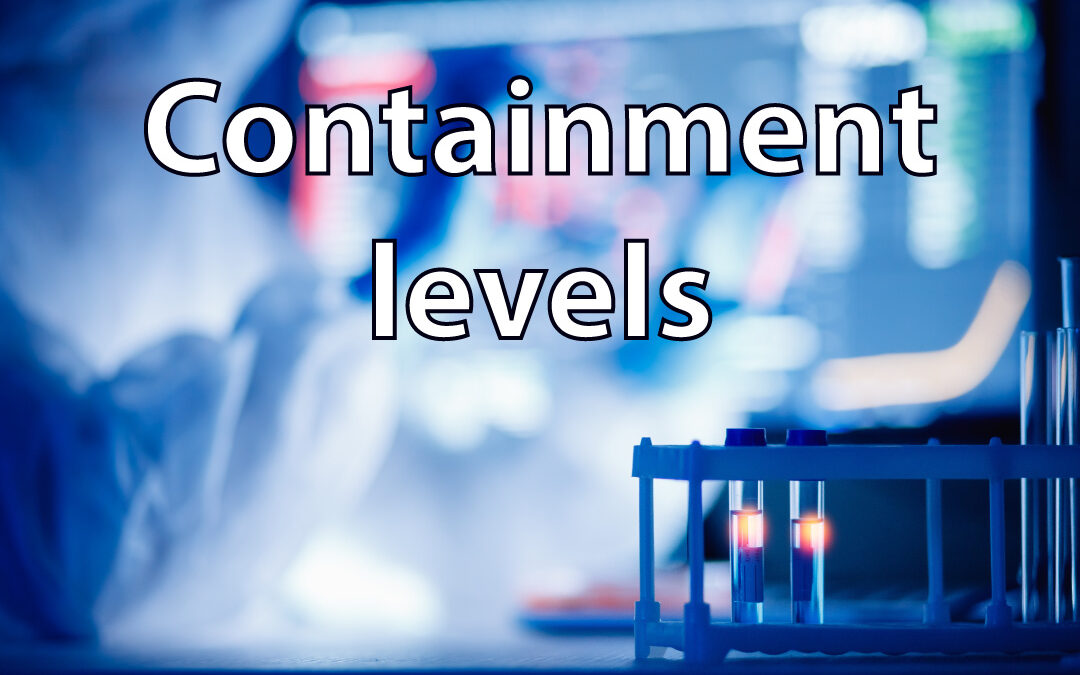Listen to this blog article:
Biological Agent Hazard Groups
We’re used to hearing about the American Biosafety Levels (BSL) system from movies, books, and of course, the media. Here in the UK, we use a different categorisation method, the Containment Level (CL). For wild-type or non-genetically modified biological agents, the system is relatively straightforward. The Advisory Commission for Dangerous Pathogens (ACDP) – through the Health and Safety Executive (HSE) – publishes “The Approved List of Biological Agents” that can be handled in UK laboratories. The ACDP assigns each biological agent (bacteria, fungi, parasites, viruses, and prions) a Hazard Group numbered 1 to 4. The designation depends on the likelihood that a particular pathogen will cause disease in humans, its level of communicability, and whether there is an effective treatment. Hazard Group 1 biological agents are defined as those that are “unlikely to cause human disease”. Pathogens in Hazard Group 4 “cause severe disease”, are likely to spread to the community, and there is usually no effective treatment available. Think Ebola virus, or the less well-known but potentially equally devastating Hendra virus.
The Specified Animal Pathogens Order 2002 sets out a similar but not always equivalent grouping system. The Genetically Modified Organisms (Contained Use) Regulations 2014 assigns GMOs to Classes (1 to 3), as the infectivity of a biological agent can be altered through genetic manipulation; this, in turn, may alter the Hazard Group designation.
Key pieces of legislation that govern the use of biological agents in the UK are: The Health and Safety at Work Act 1974, Control of Substances Hazardous to Health Regulations 2002, Animal Health Act 1981, The Specified Animal Pathogens Order 2008, The Environmental Protection Act 1990, and The Genetically Modified Organisms (Contained Use) Regulations 2014.
Containment Levels
Now we’ve defined Hazard Groups (HGs); let’s talk Containment Levels (CLs). The Containment Level required to safely handle a biological agent is usually, but not always, equal to its Hazard Group designation. So be careful not to mix up Hazard Groups and Containment Levels or use them interchangeably. Hazard Group refers to how nasty a pathogen is. Containment Level specifies the requirements for handling procedures, personal/respiratory protective equipment, and other specialised equipment and facilities. The Containment Level protects those working with pathogens, the wider community, and the environment. To contain the biological agent.
As mentioned above, HG and CL aren’t always equal. For example, SARS-CoV-2 was designated by the ACDP as a HG3 pathogen, but due to the huge volume of samples generated for testing throughout the pandemic, there simply wasn’t sufficient CL3 capacity. Therefore, sites handling SARS-CoV-2 clinical samples can apply to the HSE for a derogation, which allows them to work with the virus at CL2, albeit with stricter procedures in place and subject to risk assessment.
There are four Containment Level designations in the UK, CL1 to CL4. At Virology Research Services, we work at CL2 and CL3. Yes, you guessed it, with HG2 and HG3 human pathogens. The design requirements for CL2 and CL3 are similar; for instance, in both types of laboratories, you’ll find incubators, centrifuges, fridges, freezers, microscopes, and of course, the quintessential piece of equipment for biological containment, the microbiological safety cabinet (MSC) (you might be interested to know there are three classes of MSC, but well leave that for another day). Other similarities between CL2 and CL3 labs include the specification of materials used to cover floors and walls and those used for benching. Due to the increased hazards associated with working at CL3, there are some important differences. The HSE’s Management and Operation of Microbial Containment Laboratories guidance states that CL3 laboratories must have restricted access, an increased management standard, and workers must receive special training and be under closer supervision.
All of this becomes apparent as you prepare to enter a CL3 facility. CL3 labs are sealed units, all part of the containment measures. So, before entering, you’ll check the Magnehelic gauge to confirm the lab is under negative pressure. You’ll then record your name, room pressures, and the time in a logbook. The doorway will be locked, so you’ll need authorisation before you gain entry. Once inside, you’ll often find yourself in a lobby area where you’ll put on disposable gloves, a surgical gown or coverall, and a second pair of gloves. You may also be required to wear safety glasses or a face visor, and potentially a face mask or respirator depending on the pathogen you’re about to handle. You’re now ready to enter the CL3 laboratory proper. The atmosphere is as you’d expect, serious, quiet, there isn’t much chatter. People are concentrating on the tasks at hand, constantly aware of the hazards surrounding them. Often the only sound you’ll hear is the whirling air handling system sucking ten, twenty, maybe even forty air changes per hour through HEPA filters to protect people inside and outside of the facility. You’ll conduct work in the same manner as you would in a CL2 lab, but waste must be stored inside the MSC in an autoclave bag or disinfectant, and absorbent materials are often placed under the work area to contain drips and spills. When you’ve finished, all waste must be placed into an autoclave, usually housed within the CL3 suite, to minimise the risk of exposure during transport.
Working in the CL3 facility isn’t for everyone. Even the most competent and experienced scientist can have anxieties about working at high containment with dangerous pathogens. Here at VRS, we’re proud of our experience and expertise in working at high-level biological containment, and this allows us to deliver quality results to our clients every time.
Blog by Max Handley
Edited by Reckon Better Scientific Editing




